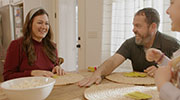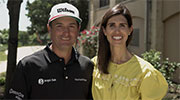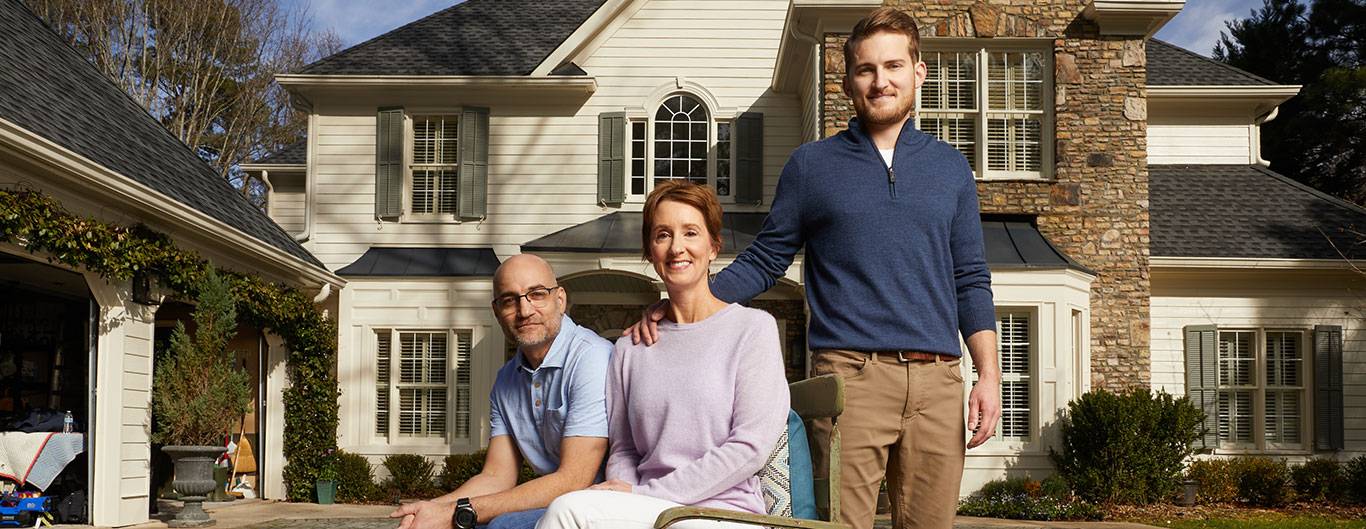Looking at Zac DiGiorgio today, you wouldn’t know he almost lost his life — twice.
Like any typical guy in his early 20’s, Zac was always on the move. He liked to keep himself busy and lead an active lifestyle.
So naturally, when his parents needed their shutters replaced, Zac was the first to volunteer. With a drill in hand, he climbed up the ladder to replace the old hardware and change out the shutters.
Moments later, everything changed in the blink of an eye.
A terrifying crash sounded from outside the home. Zac’s father, Chris DiGiorgio, rushed out the front door to see a parent’s worst nightmare: his 23-year-old son face down in the driveway, having a seizure.
After shouting to his wife to call 911, Chris was at his son’s side. He cradled Zac on the concrete driveway, trying to steady his body from the convulsions.
“I really didn’t know what was happening,” Chris recalled. “I knew he was having a seizure, but I didn’t know if he had any other injuries or anything else going on.”
But one thing was clear: Zac had plummeted to the ground from the top of the ladder, smacking the right side of his head hard on the concrete.
The severity of the fall triggered a seizure, often characterized by body spasms or unconsciousness. However, these episodes can also have cognitive and emotional effects, such as fear or anxiety.
In Zac’s case, he became extremely agitated. After waking from the initial seizure, he argued with his dad and fought against his hold. Even when the first responders arrived, he refused to get on the stretcher and instead walked himself to the ambulance.
With lights flashing and sirens blaring, the ambulance raced towards Wellstar Kennestone Hospital. On the way, Zac complained of pain in his shoulder from a broken collar bone. But after experiencing another seizure on the short eight-minute drive, it was clear much more was going on inside his body.
After being admitted, it would be weeks before Zac awoke again in the hospital — with no memory of the accident.
Performing brain operations on people like Zac is very humbling. Each patient is part of someone’s family, whether they’re a father or mother, son or daughter. At Wellstar, we never lose sight of what really matters.
– Dr. William Benedict
Wellstar Neurosurgeon
Listen to Zac’s Story
Brainpower at work
Upon arrival at Wellstar Kennestone Hospital, the DiGiorgios were escorted to a private room, waiting for word on their son’s condition. A short time later, the couple got news, but it wasn’t what they were expecting at all: although Zac had survived the fall, he had suffered a traumatic brain injury (TBI) as a result.
The DiGiorgios were blown away. “Since Zac had gotten into the ambulance himself, we thought he would just be treated for a concussion and released in no time,” Chris explained, recalling how he almost vomited when he heard about the extent of his son’s injuries.
Despite their unrest, the DiGiorgios jumped into action. Zac’s mother, Betsy DiGiorgio, started rallying a support team around her son. She made several calls to out-of-state friends and family with medical backgrounds, and they assured her that Zac was in good hands at Kennestone.
“They all said, ‘He’s in a great place. Don’t move him,’” Betsy remembers.
But despite their initial hopes, getting Zac back to better health wasn’t going to be easy due to the severity of his head injury.
Behind the scenes in the emergency room, the Wellstar team performed a CT scan, which revealed life-threatening bleeding in Zac’s brain. It quickly became clear that he was suffering from a severe TBI. With a network of experts seamlessly working together, Zac was swiftly transferred to the Wellstar Kennestone Neuro ICU for specialized brain care.
Once Zac was transferred to the Neuro ICU, Dr. Christopher Horn — a Wellstar neurologist who specializes in neurocritical care — inspected Zac’s injuries.
“When I first evaluated Zac, his imaging, labs and brain testing were not uncommon for a young trauma patient,” Dr. Horn explained. “However, he had sustained a severe lung injury likely during his seizure and it was throwing us a curveball.”
“Due to the injury, Zac was having trouble oxygenating his body. Unfortunately, that only made his intracranial pressures worse and could cause more harm to the traumatic brain injury,” Dr. Horn said, remembering the grave situation.
To control the pressures in his brain and aid in his lung function, Zac was placed in a medically-induced coma. According to Dr. Horn, the team then closely monitored Zac’s body and brain while treating him with broad-spectrum antibiotics.
“Even with treatment, his intracranial pressure would briefly respond, but still showed a worrying trend,” the neurologist recalled. “To relieve the pressure, we needed to make some space for his brain to swell.”
That’s when Wellstar Neurosurgeon Dr. William Benedict joined the team. He remembered the struggle to control Zac’s building brain pressure.
“When Zac came into the Neuro ICU, he had seizures almost immediately. We monitored his brain pressure and it kept going up,” Dr. Benedict recalled. “Ultimately, it became unresponsive to medication.”
At that point, Dr. Horn, Dr. Benedict and the Neuro ICU team knew Zac would require surgery to save his life. Together, they decided to perform an emergency craniectomy, a surgical removal of part of the skull to expose the brain and allow it to swell.
With Zac’s condition worsening, Dr. Benedict raced to the DiGiorgios to get their permission to perform the surgery. With their son in a comatose state, his parents had to call the shots when it came to his care.
“At that point, I had my game face on,” Betsy said about staying strong throughout the process and signing the surgical consent form. “I thought, ‘Let’s go. We’ve got to do it.’”
Zac was rushed into emergency surgery to save his life.
With great precision, Dr. Benedict removed part of Zac’s skull to help relieve pressure in his brain. This procedure allowed his brain to swell as needed.
The piece of skull, called a skull flap, was taken off and implanted in his abdomen between the muscle and fat. By storing it in his own body, the skull flap remains viable for reattachment in the future.
The surgery was a success. Through it all, the gravity of the situation was not lost on Dr. Benedict. He and the entire Neuro ICU team take their responsibility for patients seriously.
“Performing brain operations on people like Zac is very humbling,” Dr. Benedict said. “Each patient is part of someone’s family, whether they’re a father or mother, son or daughter. At Wellstar, we never lose sight of what really matters.”
With the help of Wellstar’s Neuro ICU team, Zac narrowly avoided death. But his path to wellness would be a long road, with many ups and downs along the way.
Continued care
Even after the craniectomy, Zac’s long road to recovery was just beginning.
Throughout the aftermath of the accident, Chris and Betsy were at the hospital day in and day out, yet throughout the process, Wellstar made the DiGiorgios feel at home.
“We really felt like we were part of the team,” Betsy said about the Wellstar physicians and nurses in charge of her son’s care.
“One of us was there 24-hours a day and they always welcomed us,” Chris added. “We could be there for him all the time.”
The Neuro ICU team kept close watch on Zac all day and all night. Leading the charge, Dr. Horn became a fixture in Zac’s room. He often would evaluate Zac, studying the beeps, whirs and readings coming from the six or seven machines keeping him alive.
After surveying the room and assessing Zac’s condition, Dr. Horn would come up with the day’s game plan, briefing with the DiGiorgios and the nurses on their next course of action.
“It was incredible to watch Dr. Horn’s mind work,” Chris remembered. “You could see the gears turning.”
“I do whatever I can to help my patients,” Dr. Horn said, sharing his philosophy on patient care. “My patients typically have a tragic or life-altering illness, and I know their life and wishes are now in my hands. The person lying in the hospital bed is counting on me to help them survive.”
Dr. Benedict also visited Zac daily to check progress, monitoring his brain closely.
“There’s a whole other world behind those closed doors,” Betsy added about the Neuro ICU and their team. “We got to experience it on a daily basis. It’s amazing what they do every day.”
Since their son was still in an induced coma, the DiGiorgios were making all the care decisions for him. Quickly, the parents learned to rely on the Wellstar care team for advice along the way.
“It’s scary at first because you don’t know what’s going on with your son,” Chris said. “But once I met with Zac’s doctors and nurses, I trusted them to do what they needed to do and if they recommended a treatment, we did it.”
“We knew we were in good hands at Wellstar,” Chris continued. “We asked a lot of questions about our son’s condition, but we never questioned what they were doing. I felt like Kennestone was the place my son could receive the best care for his injuries.”
A little over a week after his craniectomy, Zac’s brain was slowly getting better. But his respiratory system began to deteriorate. His lungs were failing because of heavy medication and relying on a ventilator to breathe.
50/50
“All the pressure from Zac’s brain had been released after the surgery, but his lungs were failing,” Betsy said, recounting the scary situation. “He was on the ventilator 100% of the time which made his lungs like plastic.”
Zac had developed Acute Respiratory Distress Syndrome (ARDS), a life-threatening condition that causes dangerously low oxygen levels in the bloodstream. Because of ARDS, the tiny sacs in his lungs — called alveoli — filled with fluid, making it more difficult for his lungs to remove carbon dioxide from his bloodstream.
That’s when Wellstar Pulmonologist Dr. Asif Saberi approached the parents about an intense treatment called extracorporeal membrane oxygenation (ECMO).
“ECMO is a way to provide air to the body when the lungs fail completely,” Dr. Saberi explained.
If the lungs are in peril, ECMO can help remove carbon dioxide from the bloodstream using a machine. Once a patient is on ECMO, blood is diverted out of the body using tubes and cleaned of carbon dioxide. It is then re-oxygenated and recirculated through the system again.
Since Zac had just had brain surgery, he was considered a high-risk patient for the treatment, but his odds weren’t looking good either way.
“Dr. Saberi told us our son had about a 50/50 shot of surviving ECMO,” Chris recounted the terrifying moment. “But if we didn’t do anything, I felt like he would die. When it’s your son, you just move forward with whatever might save him.”
“We didn’t have much time. We had to take a shot to save his life,” Betsy added.
But before moving forward, Dr. Saberi met with Dr. Horn and Dr. Benedict — the care team from the Neuro ICU — to make sure it was the right treatment for him.
“At Wellstar, ECMO is a multidisciplinary decision,” Wellstar Neurosurgeon Dr. Benedict said about his involvement in the decision. “We all came together and decided ECMO was the best option, despite the risks.”
During the procedure, a special catheter, called a cannula, was inserted in Zac’s major blood vessels to divert the blood out of his body. The cannula had dual channels: one to move blood out of the body and one to bring the reoxygenated blood back into the system.
“It really hit me after I saw the blood moving in and out of his body through the tubes,” Chris remembered seeing his son after he was placed on ECMO. “The machine was doing the work of his lungs for him.”
“At Wellstar, the medical staff is constantly growing together,” Dr. Benedict said. “With state-of-the-art programs like ECMO coming in, we all learn from each other and push each other to provide next-level care.”
Zac was placed on ECMO for over two weeks to allow his body to rest. His stiff, inflamed lungs began to recover slowly.
Finally, his family could breathe a sigh of relief.
Moving forward
After what seemed like an eternity, Zac opened his eyes.
“I felt anxious at first,” Zac remembered waking up in a hospital bed, hooked up to machines with tubes coming out of his body. “Because of all the tubes, I felt tied down and it was overwhelming. I didn’t know where I was or what had happened.”
He immediately wanted to ask his parents rapid-fire questions about the situation, but he couldn’t even say a word because of a tracheotomy.
“I couldn’t speak. I couldn’t even remember anything from the accident,” he explained. “I honestly thought I had gotten in a car crash or something.”
Pieces started coming back to Zac. It happened in flashes: the beep of a ventilator or the distant memories of visitors.
“The whole time I was in a coma, it almost felt like I was dreaming,” he recalled. “Being in the hospital, hooked up to machines and being wheeled from room to room… I thought it was a dream, but it was real life.”
From physicians to family to friends, Zac had a constant stream of visitors checking in on him after he woke up. It was a lot to take in at once. While learning about the accident, Zac had to keep all of the doctors and their specialties straight, too.
“As time passed and I got to know the doctors and nurses, I felt more comfortable,” he said. “Getting to know everyone by name and learning the hospital routines helped me feel at ease.”
The entire care team — including Dr. Horn, Dr. Benedict and Dr. Saberi — made regular visits to his room. Even after regaining consciousness and working on his rehabilitation, Zac had a lot of work to do to get back to his life.
“One of the first things that crossed my mind was my weight,” Zac said. “I dropped almost 80 pounds when I was in the hospital. One of my biggest goals was just to go back to normalcy and do everything I could do before the accident.”
That’s been one of the toughest lessons he and his family have learned throughout his recovery: it’s not always a fairy tale ending. Recovery looks different for everyone.
“In the movies, people who are given a second lease on life always go off and save the world,” Chris explained. “Zac just wanted to go back to his normal life and routine. In real life, the best part of recovering is getting your life back.”
Three months after the accident, Zac hit a big milestone in his recovery when he went into surgery to have his partially-removed skull reattached by Dr. Benedict.
“It was like a jigsaw puzzle. It went back on perfectly,” Dr. Benedict recalled how the cranioplasty procedure went smoothly without a hitch.
Zac also began rehabilitation to rebuild his strength after the accident. At first, his body was so weak that he couldn’t even walk. But he quickly met the challenges before him with strength and determination.
From taking his first few steps to running a half-marathon just months later, Zac has been making steady progress towards his goals since his hospital release. After a year and a half, he is getting behind the wheel of his car after being seizure-free for several months.
All in all, his journey to recovery has been remarkable.
“When I meet people, they don’t know that I’ve ever been hurt. They don’t know I had a life-threatening brain injury unless I tell them,” Zac said.
“Actually, there is one person who can tell what happened,” he added with a smile, “My barber — he can see the scar whenever I get a fresh haircut.”
Zac’s family is overjoyed by his recovery. They can now cheer him on as he keeps moving forward in everyday life.
“It was divine intervention. We ended up in the right place at Wellstar and it couldn’t have turned out any better,” Chris beamed.
Zac has a lot to look forward to today and in the future. From the first responders to nurses to physicians, he credits his entire care team at Wellstar Kennestone Hospital for saving his life.
“Wellstar is the reason I’m still here today.”

 AmyCare
AmyCare Kevin & Brittany Kisner
Kevin & Brittany Kisner 
